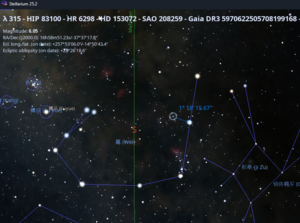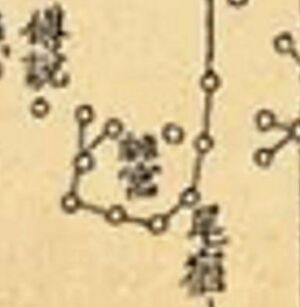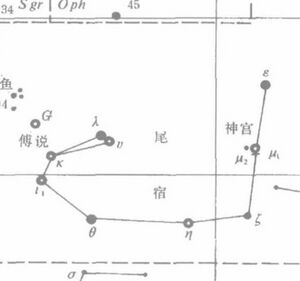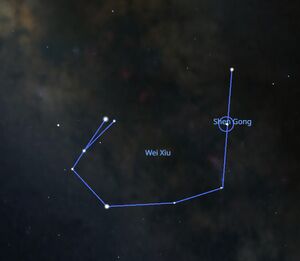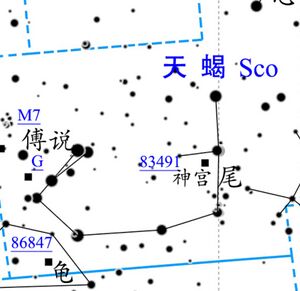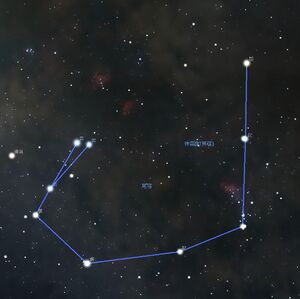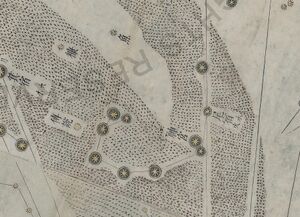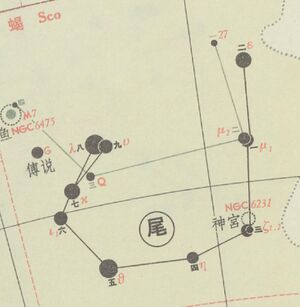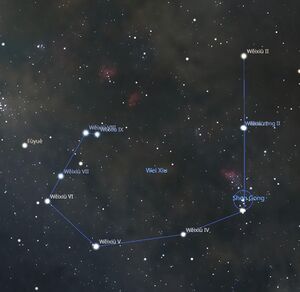Shengong: Difference between revisions
No edit summary |
No edit summary |
||
| Line 4: | Line 4: | ||
== Concordance, Etymology, History == |
== Concordance, Etymology, History == |
||
[[File:Wei Stellarium WGSN2025.gif|thumb|Chinese "Wei" (Tail)-constellation with a slightly emphasized Milky Way, simulated with Stellarium 2025. The two amorphous regions show that there are many faint stars embedded in bright clouds of the Milky Way. It suggests that ancient astronomers considered these asterisms (or "stars") as "patchy" and not as accurate dots.]] |
|||
''Shengong'' represents the intimate chamber shared by the emperor and his consorts; for a detailed discussion of its symbolism and origin, see the entry [[Wei]]. |
''Shengong'' represents the intimate chamber shared by the emperor and his consorts; for a detailed discussion of its symbolism and origin, see the entry [[Wei]]. |
||
Revision as of 07:11, 16 October 2025
Shengong (神宫, Divine Palace) is a subsidiary asterism attached to the lodge Wěi (尾), located to the left of its determinative star and consisting of only a single star.
Concordance, Etymology, History
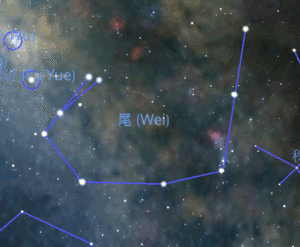
Shengong represents the intimate chamber shared by the emperor and his consorts; for a detailed discussion of its symbolism and origin, see the entry Wěi (尾).
The asterism is mentioned only in some of the historical sources: two maps and a star catalog.
The coordinates given in the star catalog are: " ... "
The position would identify with the star HIP 83100 which has only 6.05 mag (V). The star HIP 83491 is a bit further east but also a bit brighter (5.9 mag in V).
Identification of stars
According to the Kaiyuan zhanjing (Divination Canon of Kaiyuan Reign, KYZJ, compiles between 712–718 CE), Shengong corresponds to μ² Scorpii. However, in later periods some astronomers identified it with other stars. For instance, the Jingyou Star Catalogue (compiled in 1034 CE by Yang Weide) placed Shengong roughly one degree away from the determinative star, which may correspond to HIP 83000 (barely visible after atmospheric extinction) or the slightly brighter HIP 83491. In the Qing dynasty, astronomers further associated it with the open cluster NGC 6231.
| Star Names or Orders(Traditional/Qing) | Yi Shitong[1]
Based on catalogue in 18th century |
Pan Nai[2]
based on Xinyixiangfayao Star Map |
Pan Nai[3]
based on catalogues in Yuan dynasty |
Boshun Yang[4]
Song Jingyou(1034) |
|---|---|---|---|---|
| Shengong | NGC 6231 | mu2 Sco | mu2 Sco | HIP 83491 |
Maps (Gallery)
| historical map | modern identification | same in Stellarium |
|---|---|---|
Star Name Discussion (IAU)
In 2025, the name of the historical constellation "Shengong" was suggested to be used for one of the stars in this constellation. As mu2 Sco was named as Pipirima already, it is proper to apply Shengong to HIP 83491, a 5.9 mag star in Scorpius.
Decision: ...
References
- ↑ Yi Shitong伊世同. Zhongxi Duizhao Hengxing Tubiao中西对照恒星图表1950. Beijing: Science Press.1981: 56.
- ↑ Pan Nai潘鼐. Zhongguo Hengxing Guance shi中国恒星观测史[M]. Shanghai: Xuelin Pree. 1989. p226.
- ↑ Pan Nai潘鼐. Zhongguo Hengxing Guance shi中国恒星观测史[M]. Shanghai: Xuelin Pree. 2009. p443.
- ↑ B.-S. Yang杨伯顺, Zhongguo Chuantong Hengxing Guance Jingdu ji Xingguan Yanbian Yanjiu 中国传统恒星观测精度及星官演变研究 (A Research on the Accuracy of Chinese Traditional Star Observation and the Evolution of Constellations), PhD thesis, (Hefei: University of Science and Technology of China, 2023). 261.
